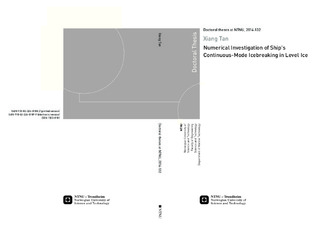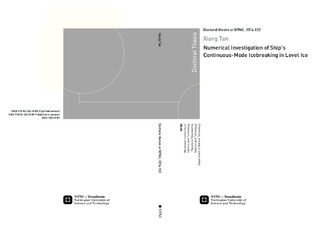| dc.contributor.advisor | Moan, Torgeir | nb_NO |
| dc.contributor.advisor | Riska, Kaj | nb_NO |
| dc.contributor.author | Tan, Xiang | nb_NO |
| dc.date.accessioned | 2014-12-19T14:50:23Z | |
| dc.date.available | 2014-12-19T14:50:23Z | |
| dc.date.created | 2014-05-27 | nb_NO |
| dc.date.issued | 2014 | nb_NO |
| dc.identifier | 719950 | nb_NO |
| dc.identifier.isbn | 978-82-326-0188-2 (printed version) | nb_NO |
| dc.identifier.isbn | 978-82-326-0189-9 (electronic version) | nb_NO |
| dc.identifier.uri | http://hdl.handle.net/11250/273126 | |
| dc.description.abstract | This thesis is a summary of studies that were carried out as part of candidacy for aPhD degree. The purpose of these studies was to evaluate some factors in shipdesign that are intended for navigating in ice using numerical simulations. A semiempiricalnumerical procedure was developed by combining mathematical modelsthat describe the various elements of the continuous-mode icebreaking process inlevel ice. The numerical procedure was calibrated and validated using full- andmodel-scale measurements. The validated numerical model was in turn used toinvestigate and clarify issues that have not been previously considered.An icebreaker typically breaks ice by its power, its weight and a strengthened bowwith low stem angle. The continuous icebreaking process involves heave and pitchmotions that may not be negligible. The numerical procedure was formulated toaccount for all of the possible combinations of motions for six degrees of freedom(DOFs). The effects of the motion(s) for certain DOF(s) were investigated bycomparing simulations in which the relevant motion(s) were first constrained andthen relieved.In the continuous-mode icebreaking process, a ship interacts with an icebreakingpattern consisting of a sequence of individual icebreaking events. The interactionsamong the key characteristics of the icebreaking process, i.e., the icebreakingpattern, ship motions, and ice resistance, were studied using the numericalprocedure in which the ship motions and excitation forces were solved for in thetime domain and the ice edge geometry was simultaneously updated.Observations at various test scales have shown that the crushing pressure arisingfrom the ice–hull interaction depends on the contact area involved. A parametricstudy was carried out on the numerical procedure to investigate the effect of thecontact pressure on icebreaking.The loading rates associated with the ship’s forward speed have been anticipatedto play an important role in determining the bending failure loads, in view of thedynamic water flow underneath the ship and the inertia of the ice. The dynamicbending behavior of ice could also explain the speed dependence of the icebreakingresistance component. A dynamic bending failure criterion for ice was derived,incorporated into the numerical procedure and then validated using full-scale data.The results obtained using the dynamic and static bending failure criteria werecompared to each other.In addition, the effect of the propeller flow on the hull resistance for ships runningpropeller first in level ice was investigated by applying the information obtainedfrom model tests to the numerical procedure. The thrust deduction in ice wasdiscussed. | nb_NO |
| dc.language | eng | nb_NO |
| dc.publisher | Norwegian University of Science and Technology | nb_NO |
| dc.relation.ispartofseries | Doctoral Theses at NTNU, 1503-8181; 2014:132 | nb_NO |
| dc.relation.haspart | Tan, Xiang; Su, Biao; Riska, Kaj; Moan, Torgeir. A six-degrees-of-freedom numerical model for level ice–ship interaction. Cold Regions Science and Technology. (ISSN 0165-232X). 92: 1-16, 2013. <a href='http://dx.doi.org/10.1016/j.coldregions.2013.03.006'>10.1016/j.coldregions.2013.03.006</a>. | nb_NO |
| dc.relation.haspart | Tan, Xiang; Riska, Kaj; Moan, Torgeir. Effect of Dynamic Bending of Level Ice on Ship's Continuous-Mode Icebreaking. . | nb_NO |
| dc.relation.haspart | Tan, Xiang; Riska, Kaj; Moan, Torgeir. Performance Simulation of A Dual-Direction Ship in Level Ice. Journal of Ship Research. (ISSN 0022-4502). 58(3): 1-14, 2014. <a href='http://dx.doi.org/10.5957/JOSR.58.3.140005'>10.5957/JOSR.58.3.140005</a>. | nb_NO |
| dc.subject | numerical model | en_GB |
| dc.subject | ship performance | en_GB |
| dc.subject | level ice | en_GB |
| dc.subject | semi-empirical method | en_GB |
| dc.title | Numerical Investigation of Ship's Continuous-Mode Icebreaking in Level Ice | nb_NO |
| dc.type | Doctoral thesis | nb_NO |
| dc.contributor.department | Norges teknisk-naturvitenskapelige universitet, Fakultet for ingeniørvitenskap og teknologi, Institutt for marin teknikk | nb_NO |
| dc.contributor.department | Norges teknisk-naturvitenskapelige universitet, Senter for fremragende forskning, Centre for Ships and Ocean Structures | nb_NO |
| dc.description.degree | PhD i marin teknikk | nb_NO |
| dc.description.degree | PhD in Marine Technology | en_GB |

